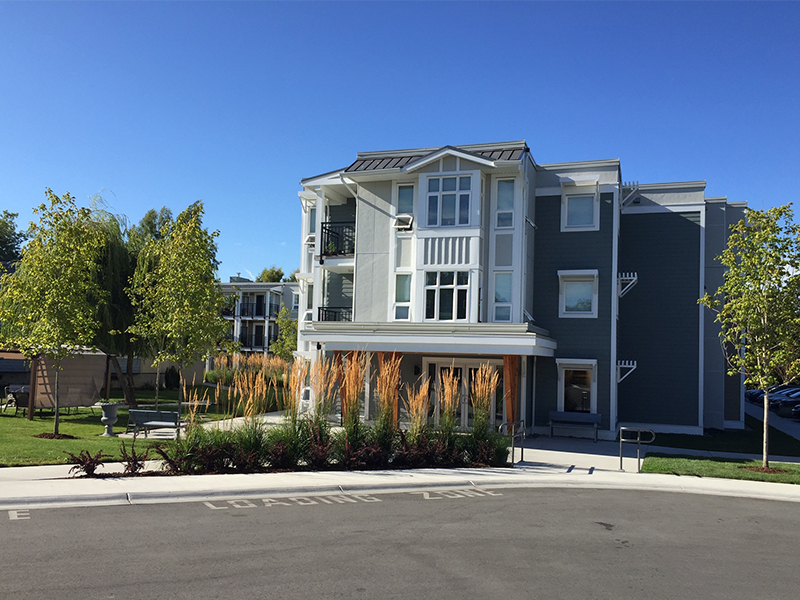
Thinking differently about economic participation and prosperity means being willing to challenge deeply embedded norms. While many Canadian financial services firms have only recently tried to integrate more purpose into their practice, Vancity is well down the track of building lasting positive change for people and the planet as a normal course of business.
We spoke with Andrea Harris, VP of Impact Strategy, about how this Vancouver-based financial co-operative is leading with their values without sacrificing profit.
Tell us about Vancity’s mission.
As a values-based financial co-operative, Vancity is committed to transforming how banking is done so we can help our members and their communities thrive financially, socially, and environmentally. This means that we use finance as a force for good to create lasting positive impact for people and the planet.
What inspired your founders to start your organization?
Canadian credit unions were established in the early 20th century, emerging at a time when traditional banks made it difficult for the average citizen to borrow or invest. Most credit unions formed around a common bond, such as a workplace, trade, church, or ethnic affiliation – which made sense since the original idea behind credit unions was to lend money on the basis of character, rather than wealth or property.
Although these common-bond credit unions increased access to credit among the working class, they still left out some groups in society. Frustrated by this, the founders of Vancity began promoting the idea of an open-bond credit union, one that was available to any resident, regardless of background. It was an unorthodox idea, but it had many supporters. And in 1946, this idea turned into reality with the creation of Vancouver City Savings Credit Union (Vancity), now the largest credit union in Canada.
What do you consider to be Vancity’s biggest success?
Since our founding, we’ve worked to widen economic participation and help our members and the communities they live in solve real-life problems and close barriers to economic participation.
Our close connections with the community and our ability to act quickly in times of crisis have allowed Vancity to provide support in ways usually limited to non-profits.
When COVID-19 broke out, we knew how we needed to respond. We supported our communities by pushing our governments to introduce broader support for everyone who was financially impacted by the pandemic. We also helped our members divert money to immediate life needs by reducing credit card interest rates to zero, deferring loan and credit card payments, and temporarily waiving fees for online and telephone transactions.

What makes Vancity unique?
We often have to remind people that Vancity is not a philanthropic charity. We are a for-profit co-operative. But thinking about the impact of our actions on people and the planet is ingrained both in how we make our profits as well as what we do with them.
We share 30% of our net profits with members and community groups every year. By the end of 2022, we will have distributed $31.9 million between our members and into partnerships to address broad and systemic needs in communities.
How do you feel your organization makes the world better?
At Vancity, we’ve translated our values into ethical principles that govern all our business decisions, and we put policies in place that guide different teams in applying these principles to their decisions. We have such policies across our business lending, community investment, and procurement.
When we’re looking at a business loan application, for example, we apply a holistic assessment process. We do what every financial institution does: we look at the financial risks and returns. But at the same time, we also look at the impact that putting our members’ capital into a project will have with respect to people and the planet. We ask ourselves whether this aligns with our values, and we apply a specific set of guidelines to our assessment.
In your opinion, how can capital be a force for good?
Financial institutions and organizations with huge capital have the power to affect systemic change, and there are many ways of doing that. For example, Vancity uses shareholder engagement to push other companies to act on climate, inequality, racism, and discrimination.
With trillions of dollars under their control globally, financial institutions have a critical role to play in addressing the climate emergency and transitioning to a clean economy. This includes changing what they fund – moving away from emissions-heavy industries to cleaner jobs and industries – and factoring climate risks and social benefits into their financial planning and reporting, their assessment of loan requests, and their investment decisions.

Tell us about Vancity’s goals.
We have a vision of a transformed economy that protects the earth and guarantees equity for all. Our strategy to build a clean and fair world involves learning to become a proactively anti-racist organization, while continuing to oppose discrimination, promote Reconciliation, and widen access to financial opportunity and prosperity.
One of the ways we try to achieve that is by creating a roadmap for delivering on our climate commitment of reaching net-zero by 2040 – meaning that by 2040, the greenhouse gas emissions from Vancity’s lending portfolio (mostly commercial and residential properties) will be eliminated or significantly reduced.
For us, commitments to net-zero are worth zero without a focus on people. We’re trying to support our members and their communities in becoming resilient, like in the face of more extreme weather events, for example.
To ensure Reconciliation is embedded into every aspect of Vancity, we added Reconciliation as a core value back in 2016 and created an Indigenous Banking Strategy. This is not a one-and-done program, but a process that continues to be improved as we support our Indigenous partners – from how we distribute grants, to how we serve members, and how we work to advance Reconciliation.
Are there any upcoming initiatives or projects you’d like to share?
For many years, Vancity has worked with organizations that help people living along the housing continuum: from emergency shelters through to transitional and subsidized housing, cooperatives, below-market rentals, and property ownership.
Since 2011, the Vancity Affordable Housing Accelerator Fund has supported the development of 4,450 affordable rental homes by providing 75 loans for 59 unique housing projects developed by 31 non-profit housing organizations. In 2021, 3,150 units of affordable housing were constructed or renovated with financing from Vancity.
We are also working with non-profit housing partners to make homes more comfortable and sustainable. Our Non-Profit Housing Retrofit Program is available to hundreds of non-profit housing providers across BC, and aims to improve energy efficiency, reduce carbon emissions, and boost the overall sustainability of BC’s affordable housing stock.
What do you most want people to know about Vancity?
We are a member-owned financial cooperative that puts the needs of its members first. We are not accountable to large shareholders and we don’t maximize profits at all costs. Since 1994, Vancity has distributed more than $422.3 million to members and communities. We want to have a positive impact on people and the planet, while continuing to be profitable.

How can people help or contribute to Vancity’s mission?
It’s important for people to know where their money goes and make responsible choices when it comes to their investments. Vancity offers only 100% socially responsible investments, but there are also many other options available that allow you to invest in line with your values.
Outside of your investment choices, another way to contribute to Vancity’s mission is to support local businesses wherever possible. And if you are a business owner, remember that how you choose to run your business matters.
For Vancity, every decision in our organization needs to have an impact lens alongside the profit lens. Other businesses and organizations can do this as well by setting impact-based business targets alongside their profit targets.
This story was featured in the Make The World Better Magazine:
Discover more stories of impact:
- Black Opportunity Fund: Supporting Black-led Businesses
- Coast Capital Savings: Helping Communities Thrive
- COIL | Our Food Future: Getting it Right on a Local Level
- Foresight Canada: Accelerating Canada Toward Net-Zero
- Harvest Impact: Nourishing a Circular Food Network
- Spring Activator: Growing Impact with Values-Aligned Capital
- Una Terra: Fighting Climate Change with Impact Investing


